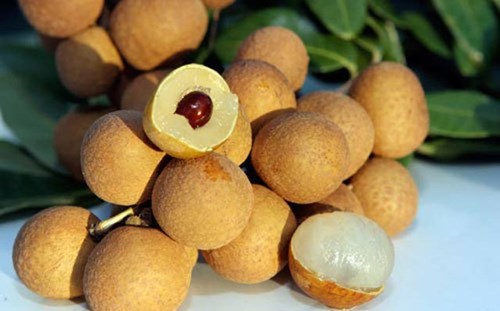5 typical signs to identify the genuine Hung Yen cage label
If it is Hung Yen's longan, the pulp will be thick and dry, especially with two very close ends. Other types of labels do not have this feature.
Distinguishing the Hung Yen longan label through 5 typical signs
In the past few weeks, in many markets and in many streets of Hanoi, there may be many shops selling Hung Yen longan. At any fruit stall, you can buy this specialty with prices ranging from 40,000-60,000 VND / kg, depending on type.
However, according to gourmets, like that label is not the 'genuine' Hung Yen cage label but Son La, Chinese or Thai labels.
So how do you know what is the name Hung Yen's cage? Consumers can rely on the following characteristics:
- About size : The cage litchi fruits are usually quite equal in size. The weight of each fruit is quite heavy, about 45-50 fruits / kg.

Hung Yen cage label has a dark yellow color, smooth and glossy skin.
- The shell and leaf labels: Hung Yen cage label is dark yellow, shiny and fresh, because it is picked and transported and consumed immediately. Meanwhile, the Chinese label also has large fruits but the shell is thinner, the leaves are also bigger and thicker than the Hung Yen longan. Chinese labels often use preservatives so the code is clean, beautiful, fast and rotten. Another type of label is Thai label, which is transported from one to two days to the wholesale market, so it is often soaked with preservatives, or closed in a closed container, so it is more susceptible to emulsion than our label. The peel of Thai longan fruit is thin, easy to be separated or just soaked in water is broken immediately.
- Longan and longan seed: Hung Yen longan is thick and dry . In particular, litchi labeled with two chests are very close together - this is a characteristic that only Hung Yen cages have. On the surface of the outside of the Hung Yen cage litchi are formed wrinkles, the balls are smooth with black-brown beads, the adhesion between the pulp and grain, the pulp and the weak shell. The rate of pulp / fruit averaged 62.7%, higher than other varieties, except for the deaf label.

Longan litchi with two chestnuts is very close together - this is a characteristic that only Hung Yen cages have.
- Flavor: When eating longan, Hung Yen is crunchy, fragrant, fragrant, it is not the aromatic smell that is gentle but gentle, fragrant and fragrant. Chinese labels when eaten taste sweet but dark, warm.
- About the season: Hung Yen cage label usually only lasts for one month, from about 20.8 to the end of September. Therefore, if you see the rampant selling market 'Hung Yen's cage' without falling in the above time, It is possible that the Hung Yen cage label is fake.
3 ways to choose good and safe labels
- When buying labels, choose green stalk labels. Do not buy labels with clean white shells, do not buy labels that have fallen branches, rotten .
- Labels using preservatives have a pungent odor, brighter shells than natural labels. Sulfur makes the bark of fruits with a lighter color, if used in high concentrations will have unpleasant smell.
- Labels purchased should be mixed with clean salt water for washing (preferably soaked in dilute salt water for about 10 minutes).
- RPG-6 enhances the quality of the Hung Yen cage label
- Selection of top-line labels to preserve specialty varieties
- How to read the fat, sugar and salt content on a food nutrition label
- The father of the barcode label died
- 8 signs to distinguish genuine iPhone cable and fake
- The smart cat opened the iron cage door
- Signs to identify people who are about to be ... struck by lightning
- Find out how to identify the
- The impact of the storm from the sun on the earth
- Signs help us recognize lung cancer
- Why should you keep the cage washer door open?
- The most typical face on the planet
 Soaking vegetables in salt water does not remove chemicals but you should still do it
Soaking vegetables in salt water does not remove chemicals but you should still do it You should limit bamboo shoots if you have 1 in 5 of these diseases
You should limit bamboo shoots if you have 1 in 5 of these diseases Mistakes when soaking vegetables in salt water
Mistakes when soaking vegetables in salt water Risk of death when combining shrimp with vitamin C
Risk of death when combining shrimp with vitamin C